|
|
|
Sort Order |
|
|
|
Items / Page
|
|
|
|
|
|
|
| Srl | Item |
| 1 |
ID:
129052
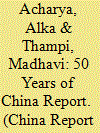

|
|
|
|
|
| Publication |
2014.
|
| Summary/Abstract |
With this issue, China Report commences its fiftieth year of publication. It seems a good time to look back over our long journey, to take stock, and also to look ahead at what our goals and priorities would be in the coming years. The China Report began its 'long march' in December 1964 as a bi-monthly, through the joint efforts of Giri Deshingkar and CRM Rao. Giri had just returned to India after completing a Bachelor of Arts in Chinese from the School of Oriental and African Studies, London, while CRM Rao, who had left a job in the corporate sector to commence work with the Radical Humanist, a journal started by the late M.N. Roy, was closely associated with a group of scholars in the Centre for the Study of Developing Societies, Delhi. It cost all of `1/- to buy a copy of China Report in those days, and for the princely sum of `5/- one could avail six copies annually
|
|
|
|
|
|
|
|
|
|
|
|
|
|
|
|
| 2 |
ID:
065427
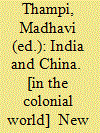

|
|
|
|
|
| Publication |
New Delhi, Social Science Press, 2005.
|
| Description |
x, 256p.
|
| Standard Number |
8187358203
|
|
|
|
|
|
|
|
|
|
|
|
Copies: C:1/I:0,R:0,Q:0
Circulation
| Accession# | Call# | Current Location | Status | Policy | Location |
| 050088 | 327.54051/THA 050088 | Main | On Shelf | General | |
|
|
|
|
| 3 |
ID:
108230
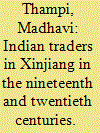

|
|
|
|
|
| Publication |
2010.
|
| Summary/Abstract |
The presence of Indian traders in Xinjiang is largely discounted as a factor of significance when analyzing the relations between India and China in the modern era. However, hundreds of Indian sojourners and settlers were present in the main towns and surrounding areas of southern Xinjiang over a period of several centuries until the middle of the twentieth century. This article explores how the rivalry between the expanding British Indian and Russian empires, as well as the turbulent politics of the Republican era in China, placed insurmountable difficulties in the way of this once-resilient group of Indian merchants, eventually leading to their complete exodus from this region of China by the late 1940s.
|
|
|
|
|
|
|
|
|
|
|
|
|
|
|
|
| 4 |
ID:
064247
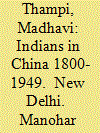

|
|
|
|
|
| Publication |
New Delhi, Manohar Publications, 2005.
|
| Description |
273p.
|
| Standard Number |
8173046158
|
|
|
|
|
|
|
|
|
|
|
|
Copies: C:1/I:0,R:0,Q:0
Circulation
| Accession# | Call# | Current Location | Status | Policy | Location |
| 049863 | 327.54051/THA 049863 | Main | On Shelf | General | |
|
|
|
|
| 5 |
ID:
133737
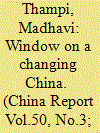

|
|
|
|
|
| Publication |
2014.
|
| Summary/Abstract |
It was not until the 1940s that India and China established diplomatic relations in modern times. This article concerns itself with the observations and impressions, based on their time in China, of two of the earliest of modern India's envoys to China, K.P.S. Menon and K.M. Panikkar. The 1940s were a watershed period in the history of both India and China, when both countries found themselves in the midst of momentous transitions. The two Indian envoys had a ringside seat from where they could closely observe and comment on the complex situation unfolding before them in China. As two articulate Indians who observed China at first hand, the writings of Menon and Panikkar offer us a unique and empathetic portrayal of China, which they viewed as a fellow Asian country facing enormous challenges not dissimilar to those of India. They show us that the governments of both India and China in this period, despite their many other preoccupations, were deeply interested in developments in the other country and in their relations with each other. At the same time, these writings also reveal that the very circumstances of the emergence of independent India and the People's Republic of China, both with a distinct sense of their own civilisational greatness and sharing a common boundary, carried latent tensions.
|
|
|
|
|
|
|
|
|
|
|
|
|
|
|
|
|
|
|
|
|